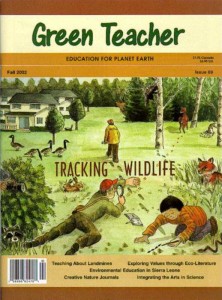Green Teacher 69, Fall 2002
 Features
Features
Tracking and Stalking the Wild: A Course Description by David Kowalewski
More than a description of his unique undergraduate course, David Kawalewski offers readers an introduction to the art of tracking and stalking wildlife, as well as useful guidelines and strategies for teaching about this indispensible means of understanding animal behaviour. Includes resources listings and contact information for the two most important tracking schools in North America.
Getting Youth Started Tracking and Stalking: Sample activities for ages 6-11 by Dan Rain
Dan Rain, a former student of David Kawalewski’s, presents several tracking and stalking educational activities that can be used with young people in both urban and rural settings.
Voices of the Land: A Course in Environmental Literature by Emma Wood Rous
Whether the topic is simplicity in Thoreau’s Walden or water pollution in Kingsolver’s Animal Dreams, literature helps students explore their place in the world and their responsibility for the world’s well-being. Literature and the Land: Reading and Writing for Environmental Literacy (Heinnemann, 2000) author Emma Wood Rous discusses the high school environmental literature course that she has taught for the last 20 years.
Creative by Nature: Integrating the arts into environmental science education by Susan A. Holmes
A primary strength of the arts is their power to move students, and this emotional connection, paired with ecological knowledge, is a powerful combination that can enhance environmental education. The author offers lesson plans and advice on integrating the the arts and environmental science.
Danger in the Earth: Teaching about landmines by Elisabeth King
This article provides educators with cross-curriculum ideas about how to introduce their students from all grade levels to the difficult subject of landmines in the developing world, and their severe economic, social, medical and environmental consequences.
The Creative Journal: A Power Tool for Learning by Willam F. Hammond
More than a place for recording observations and data, an environmental education journal can be a springboard to fresh insights and new discoveries about the natural world.
Evaluating Nature Journals by Mike Moutoux
Evaluating your students’ nature journals isn’t easy, and requires “an unusual yardstick, a device that gives credit for all kinds of seeing and thinking.” Mike Moutoux offers advice on how to approach this challenging task.
Rebuilding After War: Environmental Education in Sierra Leone by Nikki Skuce
After a decade-long civil war ended, Sierra Leone is beginning to grapple with its environmental challenges. Nikki Skuce’s article looks at the important work of the Friends of the Earth Sierra Leone and One Sky – The Canadian Institute of Sustainable Living, who are working with Sierra Leone teachers to develop a series of eco-curriculum modules and teachers’ workshops.
Inside the Internet: Matters of Debate A column by Katharine Isbell.
And as always, over 20 new educational resources are profiled and evaluated in this issue of Green Teacher.
Leave a Reply
You must be logged in to post a comment.





